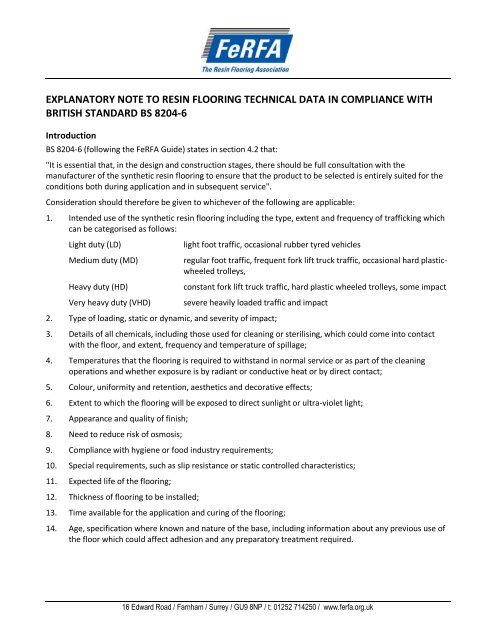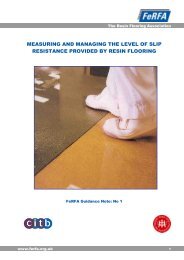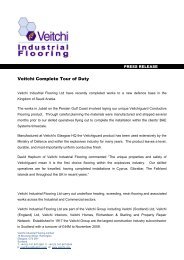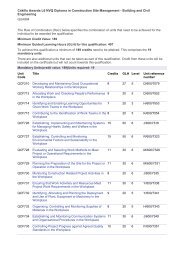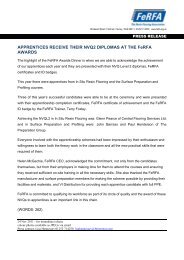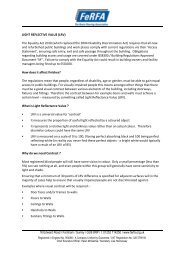Explanatory note to Resin Flooring Technical Data in ... - FeRFA
Explanatory note to Resin Flooring Technical Data in ... - FeRFA
Explanatory note to Resin Flooring Technical Data in ... - FeRFA
Create successful ePaper yourself
Turn your PDF publications into a flip-book with our unique Google optimized e-Paper software.
EXPLANATORY NOTE TO RESIN FLOORING TECHNICAL DATA IN COMPLIANCE WITH<br />
BRITISH STANDARD BS 8204-6<br />
Introduction<br />
BS 8204-6 (follow<strong>in</strong>g the <strong>FeRFA</strong> Guide) states <strong>in</strong> section 4.2 that:<br />
"It is essential that, <strong>in</strong> the design and construction stages, there should be full consultation with the<br />
manufacturer of the synthetic res<strong>in</strong> floor<strong>in</strong>g <strong>to</strong> ensure that the product <strong>to</strong> be selected is entirely suited for the<br />
conditions both dur<strong>in</strong>g application and <strong>in</strong> subsequent service".<br />
Consideration should therefore be given <strong>to</strong> whichever of the follow<strong>in</strong>g are applicable:<br />
1. Intended use of the synthetic res<strong>in</strong> floor<strong>in</strong>g <strong>in</strong>clud<strong>in</strong>g the type, extent and frequency of traffick<strong>in</strong>g which<br />
can be categorised as follows:<br />
Light duty (LD) light foot traffic, occasional rubber tyred vehicles<br />
Medium duty (MD) regular foot traffic, frequent fork lift truck traffic, occasional hard plasticwheeled<br />
trolleys,<br />
Heavy duty (HD) constant fork lift truck traffic, hard plastic wheeled trolleys, some impact<br />
Very heavy duty (VHD) severe heavily loaded traffic and impact<br />
2. Type of load<strong>in</strong>g, static or dynamic, and severity of impact;<br />
3. Details of all chemicals, <strong>in</strong>clud<strong>in</strong>g those used for clean<strong>in</strong>g or sterilis<strong>in</strong>g, which could come <strong>in</strong><strong>to</strong> contact<br />
with the floor, and extent, frequency and temperature of spillage;<br />
4. Temperatures that the floor<strong>in</strong>g is required <strong>to</strong> withstand <strong>in</strong> normal service or as part of the clean<strong>in</strong>g<br />
operations and whether exposure is by radiant or conductive heat or by direct contact;<br />
5. Colour, uniformity and retention, aesthetics and decorative effects;<br />
6. Extent <strong>to</strong> which the floor<strong>in</strong>g will be exposed <strong>to</strong> direct sunlight or ultra-violet light;<br />
7. Appearance and quality of f<strong>in</strong>ish;<br />
8. Need <strong>to</strong> reduce risk of osmosis;<br />
9. Compliance with hygiene or food <strong>in</strong>dustry requirements;<br />
10. Special requirements, such as slip resistance or static controlled characteristics;<br />
11. Expected life of the floor<strong>in</strong>g;<br />
12. Thickness of floor<strong>in</strong>g <strong>to</strong> be <strong>in</strong>stalled;<br />
13. Time available for the application and cur<strong>in</strong>g of the floor<strong>in</strong>g;<br />
14. Age, specification where known and nature of the base, <strong>in</strong>clud<strong>in</strong>g <strong>in</strong>formation about any previous use of<br />
the floor which could affect adhesion and any prepara<strong>to</strong>ry treatment required.<br />
16 Edward Road / Farnham / Surrey / GU9 8NP / t: 01252 714250 / www.ferfa.org.uk
A His<strong>to</strong>ry of <strong>Res<strong>in</strong></strong> <strong>Floor<strong>in</strong>g</strong> <strong>Technical</strong> <strong>Data</strong><br />
Synthetic <strong>Res<strong>in</strong></strong> <strong>Floor<strong>in</strong>g</strong> started life as concrete repair compounds and were <strong>in</strong>itially manufactured by<br />
companies who supplied products and additives <strong>to</strong> the concrete <strong>in</strong>dustry. The result has been that his<strong>to</strong>rically<br />
most manufactures quoted technical data such as compressive, tensile, flexural strength etc. Although pure<br />
physical test results serve <strong>to</strong> give a comparison with concrete it is clear that those same physical properties<br />
cannot be directly correlated <strong>to</strong> the performance of a res<strong>in</strong> floor<strong>in</strong>g system. In fact <strong>in</strong> some cases such as<br />
compressive strength, a very high value could produce a brittle res<strong>in</strong> which had little ability <strong>to</strong> withstand<br />
impact or thermal movement.<br />
Synthetic <strong>Res<strong>in</strong></strong> <strong>Floor<strong>in</strong>g</strong> is applied directly <strong>to</strong> a concrete substrate <strong>in</strong> thickness between a 100 microns and 25<br />
mm whereas concrete test<strong>in</strong>g is carried out us<strong>in</strong>g large cast blocks or beams. Synthetic <strong>Res<strong>in</strong></strong> <strong>Floor<strong>in</strong>g</strong> absorbs<br />
<strong>in</strong><strong>to</strong> the substrate surface produc<strong>in</strong>g a chemical bond with<strong>in</strong> the surface of the concrete and as such it is<br />
impracticable <strong>to</strong> test for physical strength properties by the same methods used <strong>in</strong> concrete test<strong>in</strong>g.<br />
In the early days of the development of synthetic res<strong>in</strong> floor<strong>in</strong>g concrete test methods were used <strong>to</strong> determ<strong>in</strong>e<br />
the strength of res<strong>in</strong> formulations but gradually it has become accepted that resilience and durability are the<br />
most important properties and pure basic strength is not important. A good comparison of why this is the case<br />
can be made by the use of Tarmac on roads.<br />
Taber Abrasion is often quoted <strong>to</strong> compare the life expectancy of synthetic res<strong>in</strong> floor<strong>in</strong>g but it can often be<br />
mislead<strong>in</strong>g because it cannot relate directly <strong>to</strong> the many diverse conditions <strong>in</strong> which res<strong>in</strong> floor<strong>in</strong>g is used.<br />
The <strong>FeRFA</strong> <strong>Technical</strong> Committee agreed that pure physical strength was not directly relevant <strong>in</strong> determ<strong>in</strong><strong>in</strong>g<br />
the suitability of a res<strong>in</strong> floor for a specific environment. In fact it concluded that durability was the ma<strong>in</strong><br />
govern<strong>in</strong>g fac<strong>to</strong>r <strong>in</strong> selection of floor<strong>in</strong>g, with the resultant classification of the various res<strong>in</strong> floor<strong>in</strong>g types <strong>in</strong><strong>to</strong><br />
8 different categories as def<strong>in</strong>ed <strong>in</strong> section 2.3 of the standard and expanded upon <strong>in</strong> the <strong>FeRFA</strong> Guide <strong>to</strong> the<br />
Selection of Synthetic <strong>Res<strong>in</strong></strong> <strong>Floor<strong>in</strong>g</strong>. Other properties which were seen as relevant were surface smoothness<br />
and slip resistance, chemical resistance, colour and u/v resistance, static control, temperature resistance and<br />
ta<strong>in</strong>t.<br />
<strong>Technical</strong> <strong>Data</strong> Format<br />
<strong>Technical</strong> data should report the follow<strong>in</strong>g British Standard/ <strong>FeRFA</strong> Guide Properties:<br />
Product Description<br />
BS 8204-Part 6 Classification<br />
Chemical Composition<br />
Thickness<br />
Typical Installations<br />
Specification Detail<br />
Life expectancy<br />
Durability<br />
Adhesive bond strength<br />
Surface smoothness and slip resistance<br />
Chemical resistance and sta<strong>in</strong><strong>in</strong>g<br />
Seals and Polishes<br />
16 Edward Road / Farnham / Surrey / GU9 8NP / t: 01252 714250 / www.ferfa.org.uk
Clean<strong>in</strong>g and ma<strong>in</strong>tenance<br />
Colour availability<br />
Resistance <strong>to</strong> ultraviolet radiation<br />
Static control properties<br />
Heat dis<strong>to</strong>rtion temperature and/ or Glass transition temperature<br />
Resistance <strong>to</strong> heat source<br />
Ta<strong>in</strong>t<br />
Reaction <strong>to</strong> fire<br />
Damp proof membrane<br />
Pot Life<br />
Cure schedule<br />
Specific gravity (mixed)<br />
Coverage<br />
Recommended application conditions<br />
Skirt<strong>in</strong>g, cov<strong>in</strong>g , gullies and dra<strong>in</strong>s<br />
Design and preparation of concrete base<br />
Strength of concrete substrate<br />
Mix<strong>in</strong>g method<br />
Prim<strong>in</strong>g<br />
Application method<br />
Consultation<br />
<strong>Technical</strong> data should emphasise the need for consultation with the <strong>FeRFA</strong> manufacturer and a contrac<strong>to</strong>r<br />
member <strong>to</strong> ensure the product selected is fit for purpose. Select<strong>in</strong>g a res<strong>in</strong> floor<strong>in</strong>g system based solely on<br />
physical test results, usually determ<strong>in</strong>ed on a labora<strong>to</strong>ry scale, is not advised. <strong>FeRFA</strong> members have experience<br />
of millions of successful projects <strong>in</strong> most work<strong>in</strong>g environments and will be able <strong>to</strong> recommend the correct<br />
product for the job.<br />
Summary<br />
<strong>Technical</strong> data is necessary <strong>to</strong> determ<strong>in</strong>e the difference between the different BS types of floor<strong>in</strong>g (type 1 – 8)<br />
but specifiers us<strong>in</strong>g res<strong>in</strong> floor<strong>in</strong>g for the first time should be aware that, because each type has several sub<br />
groups, correct specification will only be guaranteed by consultation.<br />
Always purchas<strong>in</strong>g and consult<strong>in</strong>g with a <strong>FeRFA</strong> member will ensure success.<br />
16 Edward Road / Farnham / Surrey / GU9 8NP / t: 01252 714250 / www.ferfa.org.uk


